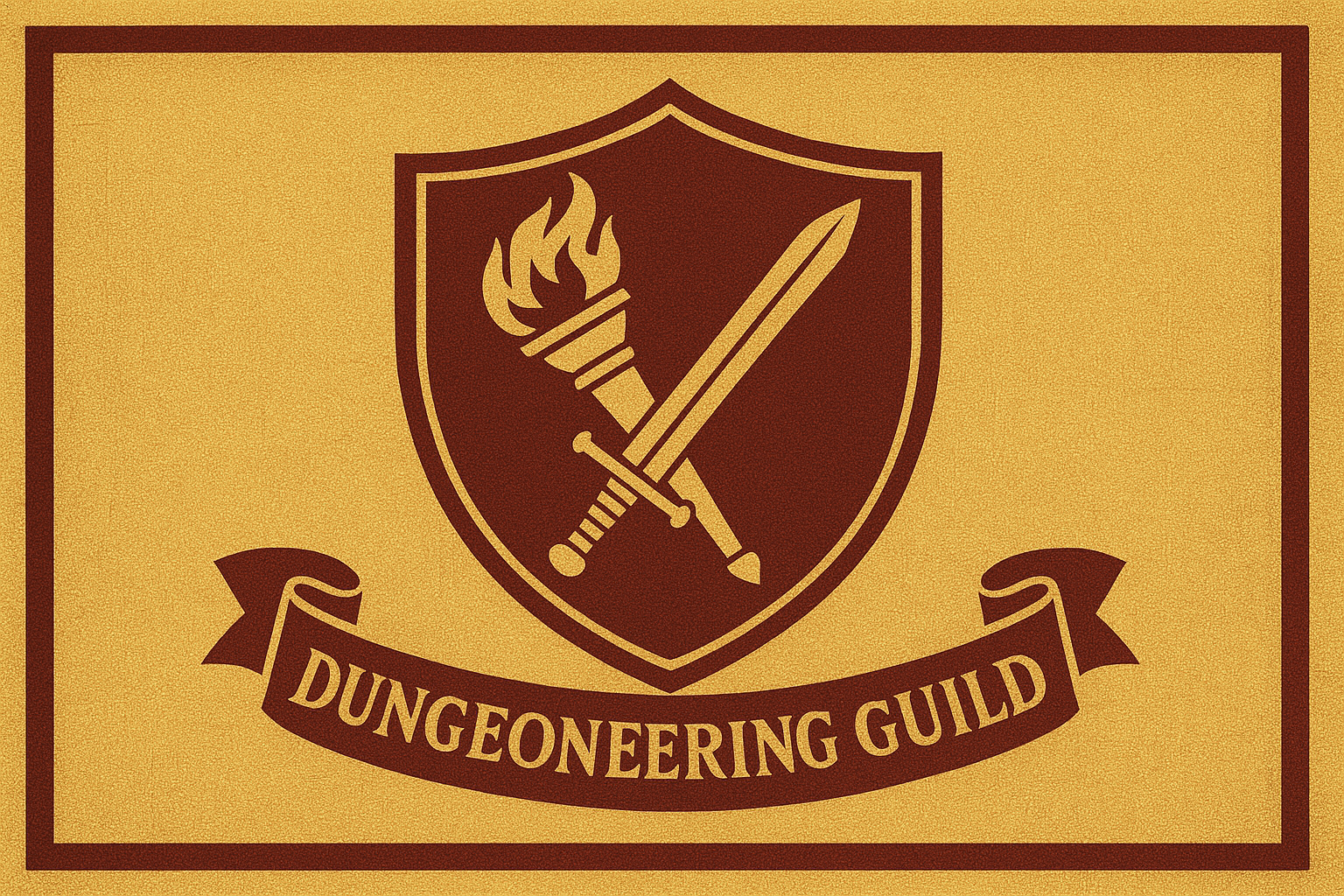Dungeoneering Guild
Among the many guilds that shape the political and survival landscape of Guildia, none are as vital—or as burdened—as the Dungeoneering Guild. Founded in the aftermath of the first dungeon-related collapse, the Guild is dedicated to locating, classifying, and ultimately neutralizing Dungeons before they escalate beyond control. Operating across the continent, the Dungeoneering Guild is often seen as both a frontier organization and a civic necessity—equal parts scouts, researchers, warriors, and undertakers of the arcane unknown. They are the first to respond when the land twists, and often the last to leave when the dust settles.
The Dungeoneering Guild operates under a simple—but profound—principle: “No dungeon must grow unchecked.” Their duty is twofold: to understand dungeons before they become a threat, and to eradicate them before they become a catastrophe. To fulfill this, the Guild is structured into two primary branches of operation.
The Surveying Division
Surveyors serve as the first line of detection. These skilled operatives are trained to locate newly formed dungeons, monitor unstable anomalies, and assess the danger level of developing cores. They travel alone or in pairs, carrying arcane instruments, scrying charms, and enchanted notebooks known as Codices—capable of recording atmospheric changes, planar pressure, and arcane bleed. Once a dungeon is found and deemed active, the Surveyor is responsible for:- Mapping the dungeon’s entrance and surrounding terrain.
- Recording its arcane signature and potential tier classification.
- Noting signs of randomcy potential (e.g., spatial distortions, gateway instability).
- Relaying a full report to Guild headquarters or a regional Warden Post.
The Clearer Division
Once a dungeon has been surveyed and deemed ready for engagement, a specialized Clearing team is assigned. These elite guildmembers are informed of the dungeon’s rank, type, threats, and—most importantly—the following core rule: Once the clearing operation begins, no assistance will be provided. This policy exists due to the ever-looming threat of Randomcy Mode—a state in which a dungeon becomes reactively sentient, evolving or warping its contents in real time when it perceives abuse or unnatural interference. Additional guildmembers entering during an ongoing clearance attempt may:- Trip the dungeon’s instability.
- Restructure its internal space.
- Close the entrance mid-operation, or worse.
- Turn the dungeon into an unwinnable death trap.
Retreatment Policy & Dungeon Attempt Protocol
Should a Clearing team retreat or fail to clear the dungeon, their file is marked accordingly in the Guild registry. Because the failed attempt itself may increase the likelihood of randomcy—especially in mid-tier and above dungeons—the Guild imposes a strict Retreatment Fee on any members who wish to attempt another clearance in the future. This fee serves two purposes:- To discourage reckless or repeat failure, ensuring only the most capable return to the field.
- To help cover containment and recalibration costs, as failed clearances often destabilize dungeons and require additional surveying measures.
Essence
To work with the Dungeoneering Guild is to walk the edge of reality and duty. While other guilds may celebrate victory in battle or fame in discovery, the Dungeoneers often operate unseen—preventing the disasters no one else understands until it’s too late.“We are the watchers of the breach. We enter once, and only once.”
Sub-Guilds: Factions Within the Guild
Though unified under a single banner, the Dungeoneering Guild is far from monolithic. Within its sprawling halls and regional chapters, there exist numerous sub-guilds—semi-autonomous factions led by veteran Surveyors, Master Clearers, or influential guild officers. These sub-guilds operate under the Guild’s larger charter but are often built around specific philosophies, tactics, or traditions handed down over generations. Joining a sub-guild is not mandatory, but most members do. The benefits are substantial—access to private training halls, rare equipment, elite mentorship, and preferential mission assignments. In return, members are expected to uphold the ideals of their sub-guild and, in some cases, carry out unique tasks or objectives during a dungeon operation. These sub-guilds serve several roles:- Training specialties (e.g., trap disarming, arcane surveying, collapse engineering).
- Operational doctrine (e.g., stealth-first, burn-it-all, relic-priority).
- Political alignment within the guild’s council structure.
- Cultural legacy or adherence to old regional traditions.
Comradery and Friction
Sub-guild membership fosters deep bonds among those who wear the same crest. Members often train together, dine together, and take joint contracts. Loyalty to one’s sub-guild can become as fierce as loyalty to the Guild itself. Camaraderie is intense, and rivalries are common—even celebrated in the form of mock duels, sparring tournaments, or academic debates over field theories. However, this structure is not without friction. Tensions rise when:- Multiple sub-guilds compete for the same high-tier clearance.
- Conflicting philosophies clash during dungeon assignments (e.g., relic recovery vs. core destruction).
- Failed missions are blamed on another sub-guild’s interference or poor intelligence.
- Sub-guild leaders clash within the Stone Circle, vying for influence over Guild policy.
- The Iron Fist – Known for their aggressive clearance doctrine and love of brute force. Prefer to obliterate dungeon cores rather than extract them.
- The Advanced – A scholarly sub-guild focused on relic recovery and anomaly preservation. Often clash with destructive sub-guilds.
- Ashroot Pact – Specialists in surveying dungeon environments and collapse engineering.
- The Black Bound – Sub-guild known for training only those who’ve survived randomcy firsthand.
Where the world breaks, we follow
Type
Guild, Professional
Alternative Names
Dungeon Guild, Divers Guild
Related Ranks & Titles
Controlled Territories



Comments